Understanding the difference between Docker containers and virtual machines (VMs) is essential for anyone working in software development, DevOps, or IT infrastructure. Both technologies help run applications in isolated environments, but they do so in different ways. In this guide, we’ll break down what Docker containers and virtual machines are, how they work, and when to use one over the other—all explained in simple, beginner-friendly language.
What is a Virtual Machine?
A virtual machine, or VM, is a software-based version of a physical computer. It allows you to run multiple operating systems (like Windows, Linux, or macOS) on a single physical machine. Each virtual machine includes a full copy of an operating system, necessary system files, and the application you want to run.
To manage these VMs, a hypervisor is used. The hypervisor acts as a middleman between the physical hardware and the virtual machines. There are two types of hypervisors:
- Type 1 (bare-metal) runs directly on hardware (e.g., VMware ESXi)
- Type 2 (hosted) runs on a host operating system (e.g., VirtualBox or VMware Workstation)
Virtual machines are fully isolated from each other and from the host machine, which makes them secure and versatile. However, since each VM runs its own full operating system, they consume a lot of resources—CPU, RAM, and storage. This can make them slow to boot up and inefficient when you need to run multiple instances.
What is a Docker Container?
A Docker container is a lightweight, standalone environment for running applications. Unlike virtual machines, containers share the host machine’s operating system kernel, which means they don’t need a full OS for each instance. Instead, they only include the application and its immediate dependencies (like libraries and system tools).
Docker is the most popular platform for creating, managing, and running containers. It allows developers to build applications once and run them anywhere—whether it’s on a laptop, server, or cloud environment.
Because containers are lightweight, they launch almost instantly and require far fewer resources than virtual machines. They’re also very portable and easy to deploy, which is why they’re commonly used in microservices architecture, continuous integration/continuous deployment (CI/CD), and cloud-native applications.
Key Differences Between Docker Containers and Virtual Machines
The major difference lies in how they isolate applications. Virtual machines isolate at the hardware level by running a full OS, while Docker containers isolate at the application level using the host OS kernel.
In terms of performance, Docker containers are much faster to start and use significantly less memory and storage. You can run many more containers on the same hardware compared to virtual machines.
When it comes to portability, Docker containers are more flexible. Since they include everything the application needs to run, you can easily move them between different systems or cloud environments without worrying about compatibility issues.
Security is another point of comparison. Virtual machines offer stronger isolation because each VM runs a full OS, making it harder for malicious code to escape the environment. Containers, while secure, share the host OS and can be more vulnerable if not properly configured.
When to Use Docker Containers
Docker containers are ideal for:
- Deploying microservices or modern web applications
- Running multiple versions of the same application
- Automating testing environments and CI/CD pipelines
- Reducing overhead in development and production
- Quick development with consistent environments
If your goal is speed, resource efficiency, and portability, Docker is a great choice.
When to Use Virtual Machines
Virtual machines are better suited for:
- Running applications that require a full operating system
- Legacy systems that are tightly coupled with a specific OS
- High-security environments where full isolation is needed
- Running different OS types on the same machine (e.g., Linux and Windows)
If your application has complex dependencies or needs a full-featured operating system, a VM might be more appropriate.
Docker Containers and Virtual Machines Can Work Together
It’s important to know that Docker containers and virtual machines are not mutually exclusive. In fact, they often work together. For example, you might use a VM to create an isolated environment on a physical server and then run multiple Docker containers inside it. This approach combines the strong isolation of VMs with the flexibility and speed of containers.
Many cloud platforms like AWS, Google Cloud, and Azure use this layered strategy to optimize performance, security, and scalability for their users.
Conclusion:
Both Docker containers and virtual machines are powerful tools for running software in isolated environments. The choice depends on your needs. If you want something lightweight, fast, and portable, Docker is likely your best option. But if your priority is strong isolation or full operating system capabilities, virtual machines may be more suitable.
By understanding the core differences between Docker containers and virtual machines, you can make informed decisions about which technology fits best for your development, testing, or production environments.




